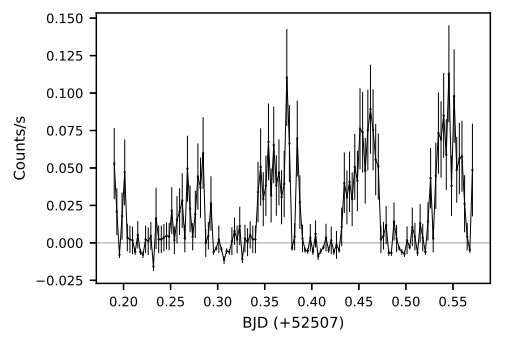April 7, 2020 report
X-ray source 3XMM J000511.8+634018 is a polar, study suggests

Astronomers from Germany and France have investigated a newly discovered variable X-ray source known as 3XMM J000511.8+634018. Results of the new study suggest that the source is a polar. The finding is detailed in a paper published March 30 on the arXiv pre-print server.
Cataclysmic variables (CVs) are binary star systems comprising of a white dwarf and a normal star companion. They irregularly increase in brightness by a large factor, then drop back down to a quiescent state. Polars are a subclass of cataclysmic variables, distinguished from other CVs by the presence of a very strong magnetic field in their white dwarfs.
Located most likely some 9,000 light years away, 3XMM J000511.8+634018 (J0005 for short) was first identified as an X-ray source in 2016 by ESA's XMM-Newton spacecraft. The object's light curve is variable and strongly reminiscent of a compact binary.
In order to shed more light on the nature of J0005, a team of astronomers led by Axel D. Schwope of Leibniz Institute for Astrophysics Potsdam (AIP), Germany, has conducted photometric observations of this source using the Bonn University Simultaneous CAmera (BUSCA) instrument on the 2.2 m telescope at Calar Alto Observatory. They also performed optical spectroscopic observations with the Large Binocular Telescope (LBT). The study was complemented by archival data from XMM-Newton the Zwicky Transient Facility (ZTF).
"We analyzed the archival XMM-Newton observation of the source, obtained BUSCA photometry in three colors, and performed optical spectroscopy with the LBT. These data were supplemented by archival observations from the Zwicky Transient Facility," the astronomers wrote in the paper.
The study found that the X-ray light curve of J0005 shows obvious bright and faint phases and the bright phases are highly variable in X-ray luminosity from one cycle to the next. This is typical for polars and indicates that an accretion region rotates in and out of view. The X-ray light curve also exhibits a stream absorption dip, which suggests an inclination between 50 and 75 degrees.
Moreover, the thermal plasma spectrum of J0005 was found to be typical of polars. It was measured that the plasma temperature of the system is about 10 keV, and that this CV contains little intrinsic absorption.
However, the orbital period of the system was calculated to be about 2.22 hours, which places it at the bottom end of the orbital period gap of non-magnetic CVs.
The astronomers assume that J0005 might be a slightly asynchronous polar, but this scenario requires further examination. Repeated spectroscopic observations with full phase coverage could be crucial in order to establish a precise value of the orbital period, what could confirm the system's asynchronous nature.
"Further photometric monitoring is likewise required to assess whether the white dwarf rotates truly synchronously," the researchers explained.
More information: Identification of 3XMM J000511.8+634018 as a new polar at P(orb)=133.5 min—is it inside or outside the period gap?, arXiv:2003.13647 [astro-ph.SR] arxiv.org/abs/2003.13647
Journal information: arXiv
© 2020 Science X Network




















